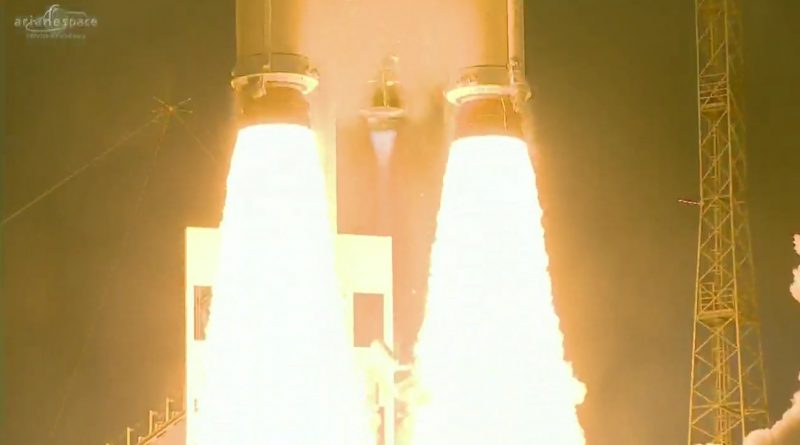Ariane 5 caps successful Year with Dual-Payload Delivery, lofting Satellites from Brazil & Japan
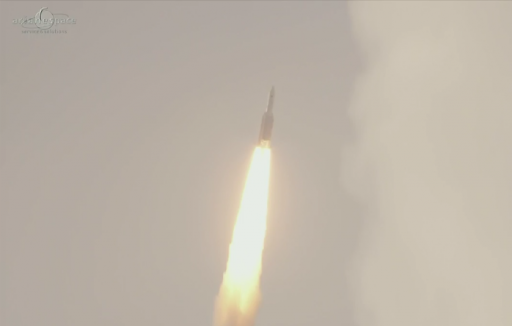
Europe’s Ariane 5 rocket rumbled away from the edge of the Amazon on Wednesday, taking flight for the last time in 2016 for a dual-satellite delivery mission to Geostationary Transfer Orbit with the Star One D1 and JCSat-15 telecom satellites for Brazil and Japan.
The 55-meter tall rocket leapt off its French Guiana launch pad at 20:30 UTC and powered uphill with twin Solid Rocket Boosters and its powerful cryogenic core stage – departing South America on the typical path to the east for a quick 20-minute flight across the Atlantic to drop its payloads off while passing over Africa.
Ariane’s rocket engines were in action for 25 minutes to inject the satellites into a highly elliptical orbit peaking nearly 36,000 Kilometers in altitude followed by an elaborate orbital dance of the vehicle’s upper stage to release its two passengers into slightly different orbital trajectories. Checking off its seventh successful mission of the year, Ariane 5 also extended its reliability record to 76 successful flights in a row – unparalleled on the commercial launch market.
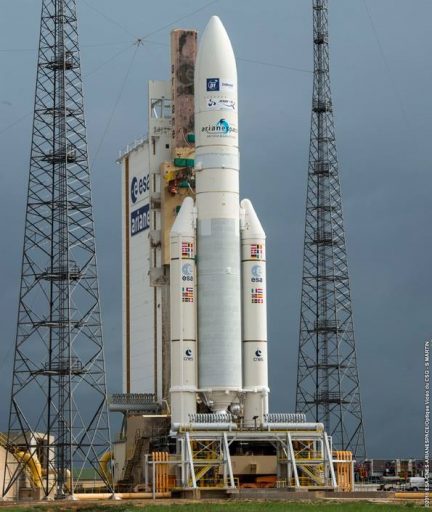
2016 has been another solid year for Arianespace, operating eleven missions with its launch vehicle fleet – seven heavy-lift deployments by Ariane 5, a pair of Soyuz missions in support of Europe’s Copernicus Earth Observation and Galileo Navigation Programs, and two flights of the light-lift Vega rocket to lift Earth observation satellites for Peru & Turkey as well as four Google-operated imaging birds.
Coming in at seven missions this year, Ariane 5 equalized the previous record set in 2009 and 2012, though Ariane’s missions were a bit more varied than in previous years – conducting single-payload missions, a direct delivery into Medium Earth Orbit and a number of dual-satellite flights.
The first two Ariane 5 missions of 2016 in January and March were unusual single-payload flights, orbiting satellites for Intelsat and Eutelsat after both companies decided to foot the bill for dedicated Ariane 5 launches to forego a wait period until suitable co-passengers could be found. Next up for Ariane 5 were three dual-payload deliveries, conducted in June, August and October to lift an international assortment of communications satellites including the first dedicated banking satellite operated by an Indonesian Bank.
2016 also saw Ariane 5 set a new record for its heaviest GTO-payload delivered to date, possible through continued optimization on the rocket such as mass reduction to increase the mass it can boost into orbit as evident in the growing payload masses lofted by the workhorse.
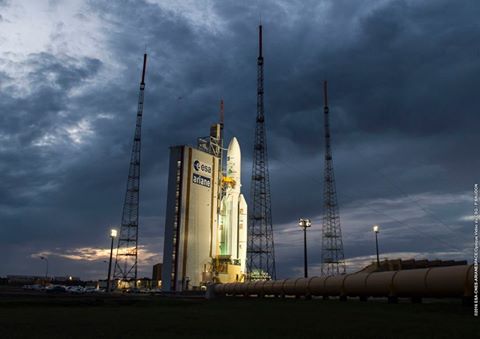
Ariane’s sixth mission of the year, performed back on November 17, marked the first mission of the Ariane 5 ES/Galileo variant that sports a number of modifications to support a direct delivery of four Galileo navigation satellites to circular orbits over 20,000 Kilometers in altitude. The launch – a full success – brought the number of active Galileo satellites to 18 and allowed the European Commission to declare the system ready for initial operations.
All in all, Arianespace delivered 27 satellites into orbit this year with a cumulative upmass of 61 tons – ranging from small 1 Kilogram CubeSats to heavy birds weighing in at nearly seven metric tons.
Wednesday’s mission, the 90th for the Ariane 5 workhorse, required the launcher to deliver a total payload of 10,722 Kilograms to Geostationary Transfer Orbit. It was the second time in 2016 that two satellites built by Space Systems/Loral shared a ride on the Ariane 5 launcher, becoming the 60st and 61st SS/L satellites launched by Arianespace.
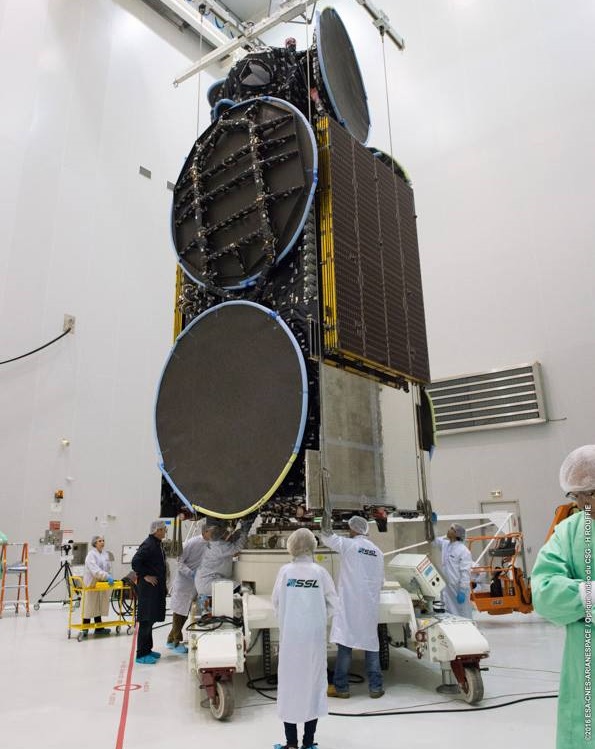
Positioned in Ariane’s upper passenger location was the five-meter tall Star One D1 satellite operated by Embratel Star One of Brazil to replace the aging Brasilsat-B4 spacecraft and expand the company’s coverage over South and Central America. The D1 satellite will provide continuity of Brasilsat’s C-Band coverage and vastly expand services via multi-band coverage.
Weighing in at 6,400 Kilograms, Star One D1 is the first in Embratel’s fourth generation of satellites and the largest launched by the company. It hosts 70 transponders operating in the C-, Ku- and Ka-Bands to deliver TV services, data distribution, broadband Internet access and cellular backhaul with particular focus on Brazil and the digital inclusion of the Latin America region.
Star One D1 will operate for at least 15 years from an orbital position at 84 degrees West longitude in Geostationary Orbit. “The D1 will help transform the lives of many people in Latin America who currently do not have access to the high-speed communications necessary for both economic and social well-being,” said Star One president Gustavo Silbert.
Arianespace and Embratel have enjoyed a fruitful business relationship for the last three decades with all eleven Star One satellites, including D1, launching on Arianespace rockets.
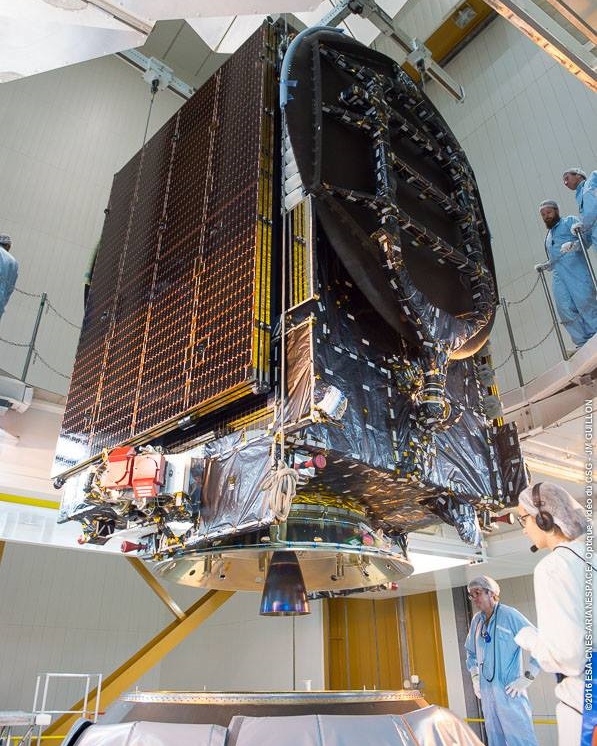
Affixed directly to the rocket’s second stage and enclosed inside the Sylda payload adapter was the smaller of the two passengers, JCSat-15 – operated by Japan’s Sky Perfect JSAT to replace the aging Superbird-D satellite launched in 2000. The 3,400-Kilogram JCSat-15 is the 18th JSAT satellite assigned to Arianespace and carries an all-Ku payload.
Operating from 110 degrees East, JCSat-15 is designed to deliver flexible communications services for HD and Ultra-HD pay-TV and free-to-air television distribution in Japan as well as data transfer and maritime and aviation connectivity over the Indian and Pacific Oceans.
Both satellites were built based on the SSL-1300 platform and launch in a busy end-of-year push for the California-based company with a total of four SS/L satellites scheduled to arrive in orbit in the second half of December.
Ariane 5 enjoyed a smooth countdown on Wednesday with clocks picking up at 8:47 UTC to kick off a methodical sequence to ready the vehicle for flight. Nearly 185 metric tons of supercold Liquid Oxygen and Liquid Hydrogen propellants were loaded into the rocket’s two stages starting four hours before launch and teams completed a final round of checkouts when the countdown passed the L-1-hour mark, setting up for a seven-minute automated countdown that put Ariane 5 through its final preparatory steps.
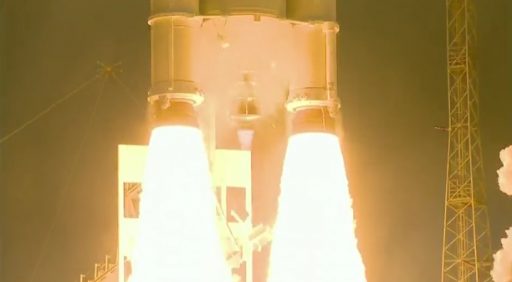
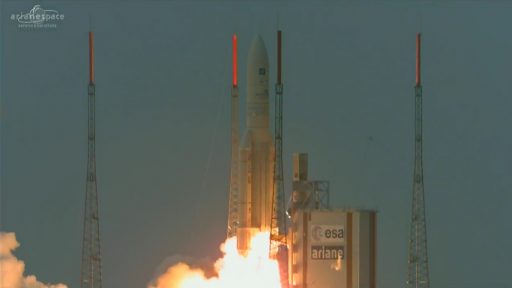
Lighting up its Vulcain 2 main engine and powerful rocket boosters, the 55-meter tall rocket soared away from the French Guiana coast line after an on-time departure at 20:30:07 UTC.
With a thrust of 1,420 metric ton force, Ariane 5 quickly aligned itself with a due easterly course, passing the speed of sound 49 seconds into the flight followed by Maximum Dynamic Pressure 20 seconds later. The twin boosters dropped away from the ascending rocket at T+2 minutes and 21 seconds after each burned through 237 metric tons of propellants to help accelerate Ariane 5 to a speed of two Kilometers per second.
Continuing under the power of the 136,500-Kilogram-force Vulcain 2 engine, Ariane 5 departed the dense atmosphere and dropped the two 17-meter long fairing halves to shed no longer needed weight and reveal the two-satellite stack. The core stage finished its job just shy of T+9 minutes with stage separation coming six seconds after the shutdown of the main engine.
The ESC-A upper stage quickly ignited its 6,400 Kilogram-force HM-7B engine on a burn of 16 minutes and 20 seconds to finish boosting the vehicle’s velocity to an injection speed of 9.35 Kilometers per second. VA234 aimed for an orbit of 250 by 35,905 Kilometers at an inclination of 6.0 degrees – standard for most Ariane 5 launches.
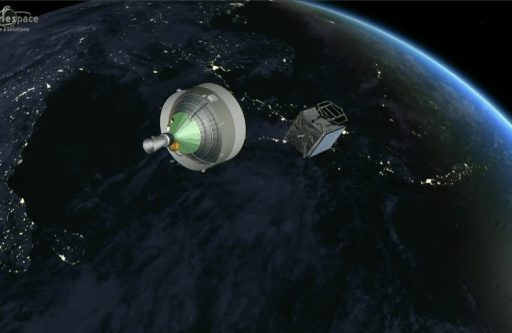
With the propulsive phase of the mission complete, Ariane 5 quickly turned to the correct orientation for the separation of the Star One D1 satellite – sent on its way 29 minutes after liftoff to embark on its 15-year mission. Following the release of its first passenger, the upper stage again fired its Hydrazine-fueled thrusters to maneuver to a different orientation for the release of the Sylda adapter 32 minutes after liftoff. JCSat-15 was pushed off its payload adapter 43 minutes into the mission.
Wednesday’s launch marked the 234th launch of an Ariane rocket in a program that premiered in 1979, it was the 90th flight of the Ariane 5, the 59th using the ECA configuration.
Arianespace will be back in action on January 28 with the launch of the Hispasat 36W-1 communications satellite atop a Soyuz ST-B rocket – the first mission of the ‘Europeanized’ Soyuz rocket to Geostationary Transfer Orbit. Ariane 5 will conduct its first flight of 2017 in mid-February with the Intelsat 32e and Telkom-3S telecommunications satellites.

